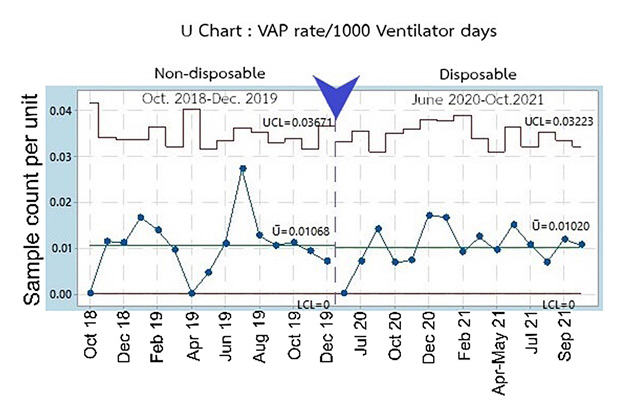Comparison Study between Using Disposable and Non-Disposable Ventilator Circuits on Ventilator-Associated Pneumonia and Health Care Costs at a Respiratory Care Unit, Siriraj Hospital
DOI:
https://doi.org/10.33192/smj.v75i3.260866Keywords:
Ventilator-associated pneumonia, health care costs, non-disposable ventilator circuits, disposable ventilator circuitsAbstract
Objective: This research aimed to compare the incidence of ventilator-associated pneumonia (VAP) and ventilator circuit costs among patients using disposable ventilator circuits and patients using non-disposable ventilator circuits.
Materials and Methods: Observational research was performed consisting of the following: A retrospective chart review of a group of patients who used non-disposable circuits (n=193) and a prospective cohort study of a group of patients using disposable circuits (n=166). The sample was purposively selected based on the following inclusion criteria: patients aged 18 years old and over who were admitted to the Respiratory Care Unit, Siriraj Hospital and ventilated >48 h.
Results: VAP incidence in the group non-disposable circuits was 10.41/1,000 ventilator days (n=27, 13.8%) and 10.82 /1,000 ventilator days (n=24, 14.4%) in the group disposable circuits (p=0.871). According to the data analysis using the U-control chart, no statistically significant differences were found. The unit cost of the non-disposable circuit was lower than that of the disposable circuit (THB 295.94), while the work unit personnel satisfaction toward working with disposable circuits was at a good level (Mean=3.83) and medium level (Mean=3.12) in non-disposable circuits (p=0.002).
Conclusion: The type of ventilator circuits had no effects on VAP rate. The unit cost of non-disposable circuits was lower than that of disposable circuits, while the work unit personnel had a higher satisfaction working with disposable circuits than non-disposable circuits.
References
The Centers for Disease Control and Prevention, National Healthcare Safety Network (NHSN). Pneumonia (Ventilator-associated [VAP] and non-ventilatorassociated Pneumonia [PNEU]) Event 2022 19 february 2022.
Chastre J, Luyt C-E. 34 - Ventilator-Associated Pneumonia. Philadelphia: W.B. Saunders; 2016. Available from: https://www.sciencedirect.com/science/article/pii/B9781455733835000348.
Ladbrook E, Khaw D, Bouchoucha S, Hutchinson A. A systematic scoping review of the cost-impact of ventilator-associated pneumonia (VAP) intervention bundles in intensive care. Am J Infect Control. 2021;49(7):928-36.
Klompas M, Branson R, Eichenwald EC, Greene LR, Howell MD, Lee G, et al. Strategies to Prevent Ventilator-Associated Pneumonia in Acute Care Hospitals: 2014 Update. Infect Control Hosp Epidemiol. 2014;35(8):915-36.
American Thoracic Society, Infectious Diseases Society of America. Guidelines for the Management of Adults with Hospital-acquired, Ventilator-associated, and Healthcare-associated Pneumonia. Am J Respir Crit Care Med. 2005;171(4):388-416.
Altinsoy S, Catalca S, Sayin MM, Tutuncu EE. The risk factors of Ventilator Associated Pneumonia and relationship with type of tracheostomy. Trends in Anaesthesia and Critical Care. 2020;35:38-43.
Patil HV, Patil VC. Incidence, bacteriology, and clinical outcome of ventilator-associated pneumonia at tertiary care hospital. J Nat Sci Biol Med. 2017;8(1):46-55.
Centre for Nosocomial Infection Control of Siriraj Hospital. Annual disease surveillance report 2018-2021. 2022.
Waters B, Muscedere J. A 2015 Update on Ventilator-Associated Pneumonia: New Insights on Its Prevention, Diagnosis, and Treatment. Curr Infect Dis Rep. 2015; 17(8):496.
Goel V, Gupta S, Goel T. Ventilator-associated pneumonia: a review of the clinically relevant challenges in diagnosis and prevention. British Journal of Medical Practitioners. 2016; 9(2):18.
Keyt H, Faverio P, Restrepo MI. Prevention of ventilator-associated pneumonia in the intensive care unit: a review of the clinically relevant recent advancements. Indian J Med Res. 2014; 139(6):814-21
Michael Klompas. Risk factors and prevention of hospital-acquired and ventilator-associated pneumonia in adults. UpToDate. 2022.
Li Y-C, Lin H-L, Liao F-C, Wang S-S, Chang H-C, Hsu H-F, et al. Potential risk for bacterial contamination in conventional reused ventilator systems and disposable closed ventilator-suction systems. PLoS One. 2018;13(3):e0194246.
Srisan P, Meechaijaroenying K. Comparison of ventilator-associated pneumonia in children using disposable and nondisposable ventilator circuits. Pediatric Respirology and Critical Care Medicine. 2017; 1(4):77-80.
Pen DL, Yan GF, Chen WM, Liu J, Ying JY, Lu GP, et al. The role of bacterial colonization of ventilator circuit in development of ventilator-associated pneumonia: a prospective observational cohort study. Clin Microbiol Infect. 2021;27(3):467.e1-e7.
Koenig SM, Truwit JD. Ventilator-associated pneumonia: diagnosis, treatment, and prevention. Clin Microbiol Rev. 2006; 19(4):637-57
Rodrigues J, Sousa P. Economic and Clinical Impact of Ventilator-Associated Pneumonia in Intensive Care Units of a University Hospital Center. Cham: Springer International Publishing; 2019.
Kollef MH, Hamilton CW, Ernst FR. Economic Impact of Ventilator-Associated Pneumonia in a Large Matched Cohort. Infect Control Hosp Epidemiol. 2012; 33(3):250-6.
Innok S, Dokphueng W, Udol K, Slisatkorn W, Sawasdiwipachai P. Clinical Outcomes and Cost of Ventilator Weaning and Endotracheal Extubation Guided by An Established Ventilator Weaning Protocol in Patients Undergoing Elective Cardiac Surgery. Siriraj Med J. 2021;73(12):815-22.
Kheiawsawang M, Sopaporml O, Siripitayakunkit A, Sutherasan Y. The effects of nursing practice guidelines to prevent ventilator associated pneumonia (VAP) in Medical Intensive Care Unit, Ramathibodi Hospital. Mahidol R2R e-Journal. 2020; 7(1).
Siriraj_KM. Siriraj Concurrent Trigger Tool by Modified Early Warning Signs (SiCTT by MEWS) 2021 26 Feb 2022. Available from:https://www2.si.mahidol.ac.th/km/cop/sicop/sictt/16798/.
Thamcharoentrakul B, Saensom D. Effects of Using Nursing Practice Guideline for Ventilator Associated Pneumonia Prevention: Medical Department. The Journal of Baromarajonani College of Nusing, Nakhonratchasima. 2019; 25(1).

Published
How to Cite
Issue
Section
Categories
License
Copyright (c) 2023 Siriraj Medical Journal

This work is licensed under a Creative Commons Attribution-NonCommercial-NoDerivatives 4.0 International License.
Authors who publish with this journal agree to the following conditions:
Copyright Transfer
In submitting a manuscript, the authors acknowledge that the work will become the copyrighted property of Siriraj Medical Journal upon publication.
License
Articles are licensed under a Creative Commons Attribution-NonCommercial-NoDerivatives 4.0 International License (CC BY-NC-ND 4.0). This license allows for the sharing of the work for non-commercial purposes with proper attribution to the authors and the journal. However, it does not permit modifications or the creation of derivative works.
Sharing and Access
Authors are encouraged to share their article on their personal or institutional websites and through other non-commercial platforms. Doing so can increase readership and citations.














